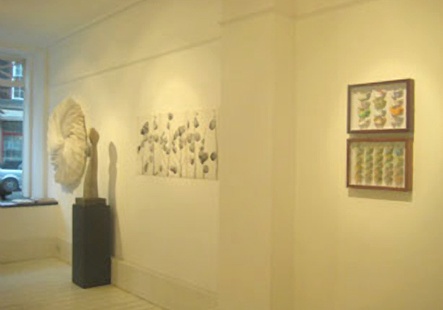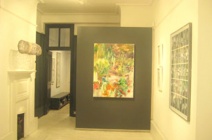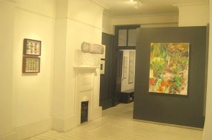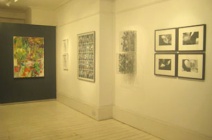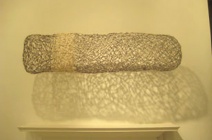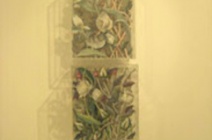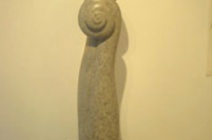without my journey and without the spring I would have missed this dawn
without my journey and without the spring I would have missed this dawn
Andrew Carter, Antonia Spowers, Claire Brewster, Helen Ireland, Jude Tucker, Kathleen Mullaniff, Kazuhito Takadoi, Patricia Swannell, Ricardo Cinalli, Sally Haworth, Tracey Bush, Valentin Wormbs
Paintings, photographs, works on paper and 3 dimensional works that celebrate new life
Old letters and envelopes, stamps, maps or musical scores give shape to Tracey Bush's butterflies. Butterflies are amongst the first indicators of environmental change; these paper ones caged in museum boxes remind us of their frailty and diversity. Each butterfly is an actual species and is life size and each is made with an allusion to its name or habitat. Bush's beautiful butterfly boxes not only aim to support the species but are a reflection of our consumer culture.
Claire Brewster treats old maps as the fabric to create an invented flora and fauna of a place. Delicate, Intricate, detailed cut out tulips emerge resembling elaborate lace or tapestries. Ideas of freedom, origin, as a current political reality and issues of biodiversity, the migration of foreign species and the consequent damage to the environment underlie her beautiful works
Andrew Carter's exquisite prints start with the chance arrangements of shapes discovered in the landscape. Through careful observation and design the subject is reduced to one or two colours, considering the pattern, surface and atmosphere of a place and time that conveys a poetic analogy to something seen, felt or remembered.
Beautiful, luscious flowers emerge from Ricardo Cinalli's works. But beauty is always threatened by decay and the passage of time. There is a perverse and cruel reality of the thorns and spines interwoven in his dramatic works.
Sally Haworth's black and white photographs of orchids are sensuous and intimate. Small in size the images capture a close up of the flowers, revealing the beauty and majesty of their form. Light and composition converse leading the viewer into their midst, where the uniqueness of their character is discerned. Alluring and elegant, poised and seductive, they are a beauty to behold.
Helen Ireland uses the shapes of leaves, seaweed and other natural forms, exploring the use of cut paper and collage to create arrangements that are 'all over' in appearance. On closer inspection these works reveal identification with the delicate character of individual plant forms. These works are made in multiples that invite the viewer to discover differences between forms and their compositional placement.
Kathleen Mullaniff's large colourful canvases sumerge the viewer in an overgrown garden of moss, forget-me-nots and horses tail. Whilst restoring a Victorian garden, she has worked directly from the plants, drawing and painting the process. "Digging, clearing and re-arranging, finding lost plants, the old shrubs left, new trees, old trees, new bulbs, old bulbs. Planting, digging, growing. Tulips, daffodils, clematis and honeysuckle". These images are in one layer of oil paint, they are direct and immediate.
For Antonia Spowers, physical materials are very important and she is interested in their ability to embody and express ideas such as transformation. Her work relates to landscape whether natural or man made, within or without. Her treated cartridge paper Spin continues her recurring interest in circular form, in many disguises, suggesting themes of continuity and connection. The sense of continuity is reflected in the feeling of buried layers in the landscape and the re-cycled patterns of energy from the past.
Patricia Swannell imprints a feather, grass or leaf, rendering the ephemeral and temporary permanent. "I am haunted by the current threat to the natural world and the self-destructive illusion that our own fate could somehow be different from the fate of the environment we inhabit. My work seeks to prompt a new awareness by directing attention away from mass consumption towards the beauty of what lies, often literally, beneath our feet. The fragility and transience of simple fragments - seeds, seedpods, grasses, feathers - call for protection and offer the possibility of a different future through an altered system of values."
Kazuhito Takadoi's works are made from grass that he grows in his back garden. They are intricate, organic and about time: the time for the grass to grow tender so that, again with patience, it can be carefully embroidered into the hand made paper. Sometimes the grass, with time, fades and matures into gold.
Jude Tucker's graceful sculptures and carvings in stone depict a series of familiar flowers, trees and seeds. The ephemeral delicacy of her subject is underlined by its translation into an immutable form. Time is halted - a moment preserved - in the sensitively rendered works. Using a variety of different stones, Jude Tucker presents a series of sometimes intricate works which celebrate natural beauty and form.
In his photographs Valentin Wormbs explores the relationship between image and space, between picture as likeness or as a staged representation. His photographs are taken with black and white negative film and then solarised during the developing process. Drawing on the classical genre of still life with flowers, he explores the questions of ornamental artifice and fairy-tale uncanny naturalness by playing with scale and emphasizing details.

